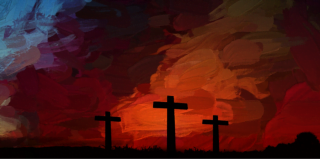This is a longer than usual piece. So grab a cuppa and take some time…
For most of my life I’ve thought that the Old Testament sacrificial system was a way for people to be forgiven for their sins. The death of an animal was a powerful reminder to Israelites that they deserved to die for their sin, but that God accepted the animal as a substitute for them.
This then affected the way I read the story of Jesus. When he forgave sins without requiring people to offer sacrifices at the temple, he was effectively declaring that he, not the temple, now represented the presence of God. When he died on the cross, he became the sacrifice of all sacrifices, paying the penalty for my sins so that I could be free.
Recently I have been reading through the Old Testament teaching around sacrifice. It’s not something we often do, for it is a very foreign world with its talk of things and places being holy, clean or unclean, and is full of intricate and detailed rules regarding ways sacrifices are to be made. Given we no longer make sacrifices it is difficult to be motivated to explore these texts. Yet I have been surprised to discover that the Old Testament sacrificial system was not about the forgiveness of sin but the ritual cleansing of the pollution of sin. This has significant implications for how we understand Jesus and his death.
The sacrificial system is described in the books of Exodus, Leviticus, Numbers and Deuteronomy. Leviticus the most extensive. There were five types of sacrifice:
1. Burnt offering
2. Grain offering
3. Fellowship offering
4. Sin offering
5. Guilt offering
The two sacrifices related to forgiveness of sin were the sin offering and the guilt offering. These are extensively described in Leviticus chapters 4-6. They were not sacrifices for the forgiveness of sins in general, but could be offered only for “unintentional” sins. Chapter 4, which describes the sin offering, begins
“when anyone since unintentionally and does what is forbidden in any of the Lord’s commands…”
In verse 13 it continues
“if the whole Israelite community since unintentionally does what is full beaded in any of the Lord’s commands, even though the community is unaware of the matter, when they realise their guilt and the sin becomes known, the assembly must bring a young bull was a sin offering…”
The guilt offering seems to be distinguished by the fact that it is for unintentional sins “in regard to any of the Lord’s holy things” (5:15).
The sacrificial system did not provide a means by which the adulterer, the murderer, the thief, the violent, the oppressive, could find forgiveness for their sins. The Old Testament law was quite explicit that those who engaged in such behaviours were to be removed from the community because their behaviour represented a flagrant and destructive breach of the community’s calling, or they were required to make recompense in order to set the breach right. Where forgiveness does occur it is not obtained through the offering of sacrifice but as a free and gracious act of God.
The sacrificial system was an integral part of Israel’s purity system. It is difficult for Westerners to get our heads around, because it represents such a foreign way of thinking. We frame holiness and purity in terms of morality. Israel extended holiness to the ritual state of things and people. People, places and things existed in one of three states: holy, clean, or unclean. Those things closely associated with God were considered “holy”, most things were considered clean, but certain things in certain states of being could be considered unclean. For example, certain types of animals were considered unclean. A person could become unclean by eating these animals, or in a variety of other ways such as through an emission of bodily fluids such as semen or blood, or by touching something that was clean such as a dead body. When that occurred, there were a number of purification rituals that needed to be undertaken in order to restore them to a state of cleanness. It was quite normal for a person to become unclean and to then go through the process of being made clean again.
Because the land in which Israel lived was owned by God and because God dwelt amongst the people in the tent of meeting, it was important that the holiness of the tabernacle and the priests be preserved and that the cleanness of the people and the land be preserved. The sacrificial system served a number of goals, but the sin and guilt offerings represented a way of making purification for the offenders and of the tabernacle. The animal was not slaughtered on the altar, but outside the tent of meeting. The priest would take blood from the animal and sprinkle it on parts of the tent of meeting and burned particular portions of the animal in order to create an aroma pleasing to God. The blood of the animal appears to have been accepted as some kind of cleansing agent.
Yet what of those intentional sins, for which people had either been required to make restitution or to be cut off from the community? They not only created individual guilt but created an accumulation of uncleanness that needed to be cleansed. This occurred
on the annual Day of Atonement. Described in Leviticus 16, this involved the cleansing of the tabernacle through the sprinkling of the blood of a slaughtered goat and the cleansing of the people through the use of a scapegoat.
First there was a cleansing of the tabernacle.
[Aaron] shall slaughter the goat of the sin offering that is for the people and bring its blood inside the curtain, and do with its blood as he did with the blood of the bull, sprinkling it upon the mercy seat and before the mercy seat. Thus he shall make atonement for the sanctuary, because of the uncleannesses of the people of Israel, and because of their transgressions, all their sins; and so he shall do for the tent of meeting, which remains with them in the midst of their uncleannesses… Then he shall go out to the altar that is before the Lord and make atonement on its behalf, and shall take some of the blood of the bull and of the blood of the goat, and put it on each of the horns of the altar. He shall sprinkle some of the blood on it with his finger seven times, and cleanse it and hallow it from the uncleannesses of the people of Israel.
Atonement here does not refer to the forgiveness of sin as release from the penalty of sin, but to the cleansing of the tent of meeting, including the “mercy seat”, which was the cover on the ark of the covenant and the place God’s presence was manifest.
Having made atonement for the tabernacle, the tent of meeting, the altar and the mercy seat, atonement was then made for the people through the sending of a scapegoat into the wilderness.
When he has finished atoning for the holy place and the tent of meeting and the altar, he shall present the live goat. Then Aaron shall lay both his hands on the head of the live goat, and confess over it all the iniquities of the people of Israel, and all their transgressions, all their sins, putting them on the head of the goat, and sending it away into the wilderness by means of someone designated for the task. The goat shall bear on itself all their iniquities to a barren region; and the goat shall be set free in the wilderness.(verses 20-22).
There has been significant discussion as to exactly what the goat does and how it bears away the sins of the people. We should be clear that it does not involve forgiveness in the sense we speak about it today. The Day of Atonement ritual did not mean that those who had intentionally and openly broken the law of God would be forgiven. The penalties were quite clear in the law. Rather it seems to be that the ritual uncleanness that accumulated in Israel was cleansed.
In addition to the regular sacrifices and the Day of Atonement, Israel also celebrated a Passover once a year. It was commemoration of the final act of God to liberate the Israelites from their Egyptian slave masters. The story is recorded in Exodus 12. God would
pass through the land of Egypt…[and] strike down every firstborn in the land of Egypt, both human beings and animals
The Israelites were to share a meal together and apply some of the blood of the animal they slaughtered upon the doorframes of their homes.
The blood shall be a sign for you on the houses where you live: when I see the blood, I will pass over you, and no plague shall destroy you when I strike the land of Egypt.
Every year when the Israelites gathered together to re-enact the Passover they were reminded of this occasion on which God passed over their households with an act of judgement against their oppressors in order to liberate them from slavery to be a new community.
So what does all this mean for how we understand Jesus? First, when Jesus went around declaring people’s sins were forgiven, he was not assuming for himself the prerogatives of the temple. The sacrificial system did not result in the forgiveness of sins but in the cleansing of the land, the people, and the tabernacle from the accumulated uncleanliness their sin created. Forgiveness, in the sense of release of a person from the penalty of their sin, was something that only God could offer and was done quite independently of the sacrificial system. When Jesus offered forgiveness to a woman caught in adultery, to a renowned sinful woman who washed his feet with her tears, and to a tax collector like Zacchaeus, he was assuming the prerogative of God to freely and unilaterally forgive. And Jesus made clear that this free and unilateral forgiveness was available to all.
Second, we must stop importing the doctrine of penal substitution into our understanding of Jesus’s death as a sacrifice. The Bible writers use the metaphors of Passover and the Day of Atonement to describe what Jesus did. The blood on the door posts marked them out as those whom God was liberating from the Egyptians, in order to bring them to the land of Israel where they might live as God’s people. Jesus was enacting a second Passover, in which God’s people were being liberated from the power of sin in order that they might live as those who reflected the character of Jesus.
On other occasions the New Testament seems to have in mind the day of atonement. In a complex and much debated passage, Romans 3: 21-26, Paul explicitly refers to the cover on the ark of the covenant that was cleansed on the Day of Atonement (the term is commonly translated as “sacrifice of atonement” and then given a penal substitutionary meaning), and seems to bring together the idea that Christ is the place where God meets us and that the shedding of his blood served to cleanse us. This is certainly the way Jesus’s death is read in Hebrews 9 and 10. In 2 Corinthians 5 Paul talks about Christ being “made sin for us, so that in him we might become the righteousness of God”. Reading this against the Old Testament Day of Atonement does not picture a legal transfer of sin from us to Christ who dies to pay the penalty for it and a transfer his righteousness to us. Rather in which probably refers to the scapegoat, who carries our sin away and in doing so cleanses us.
By using these metaphors the Bible writers pointed to some important realities: that we need to be liberated from those things that have mastery over us in order to become the people God created us to be, and that in the death of Jesus God provided a way for us to be cleansed so that we might begin being those people were created to be; and that God’s heart is to fully and freely forgive.








“…in the death of Jesus God provided a way for us to be cleansed so that we might begin being those people were created to be…”
What a liberating offer. I’d call that very good news indeed!
Thanks for suggesting some significant re-thinking, Scott. I hope you will excuse a naive sort of question, whihc may also be slightly ‘off topic.’
When a person believes in Christ it’s common to say their sins are forgiven. Do you take that to mean all sins both past, present and future? Or is there a continuing need of conviction and repentance? And if so, how can the conscience ever be set free in this life, when you are sort of ‘looking over your shoulder’ all the time?
Hi Scott, You’ve said that the sin and guilt offerings in the OT Law were only for “unintentional” sins. I don’t think that’s always true. Lev 6:1–7 [Heb 5:20–26] are clearly for intentional sins (there is no reference to “unintentional” in the passage and it is difficult to conceive of how someone could possibly unintentionally do the things that are listed there). And quite a range of intentional sins do seem to be mentioned in this passage. Forgiveness in Lev 6:1–7 comes through both sacrifice and restitution with interest. I’d also add that it’s difficult to see how the repeated… Read more »
Hi Martin, Yes, there is a small catalogue of sins mentioned in Leviticus 6 that go beyond the pattern of “unintentional” sins described in chapter 5. I note that Gordon Wenham (NICOT on Leviticus) sees the common thread that binds the sins described under the “guilt offering” is the notion of reparation for property violations. So it would be better for me to say that there were offerings for the pollutions caused by unintentional sins and offerings of restitution for property offences. This however doesn’t really change my argument, which his that the point of the sacrificial system was not… Read more »
Hi Scott, Thanks for your reply! It raises some more questions for me though. If sins are the cause of pollution that needs to be remedied, couldn’t this just be cultic symbolism for forgiveness? If sin causes impurity and restoration requires sacrifice, then is it not possible that the whole system becomes a metaphorical representation of forgiveness and reconciliation? Otherwise what is the point of it all? And there does seem to be, even just in Lev 6:1–7, some hope for forgiveness of some of the commandments (i.e. “You shall not steal” and “Do not give false testimony…”). On “soothing… Read more »
Hi Scott,
How much of your thinking in this area has been formed by Rene Girard?
Dan